Biomass Feedstock and Climate Change in Agroforestry Systems: Participatory Location and Integration Scenario Analysis of Biomass Power Facilities
Abstract
:1. Introduction
2. Materials and Methods
2.1. Case Study Area Description
2.2. Participatory Multi-Criteria Method Description
2.3. Survey Modeling Description
3. Results and Discussion
3.1. Participatory Spatial Location Analysis
3.2. Survey Modeling Analysis of Integration Scenarios
3.3. Study Discussions, Comparisons and Limiations
4. Conclusions
Author Contributions
Acknowledgments
Conflicts of Interest
Nomenclature
| AHP | analytic hierarchy process |
| ASPS | agro-silvo-pastoral system |
| ESDSS | energy spatial decision support system |
| e | decision-maker preference |
| EU | European Union |
| F-DEMATEL | fuzzy-decision-making trial and evaluation laboratory |
| FIT | feed-in-tariff |
| GHG | greenhouse gas |
| GIS | geographic information system |
| k | total number of decision-maker |
| MCDA | multi-criteria decision analysis |
| n | number of criteria |
| PCM | pairwise comparison method |
| P | final criteria |
| PSP | participatory spatial planning |
| SAW | simple additive weighting |
| SI | suitability index |
| TFN | triangular fuzzy number |
| xij | grading value of area i under criterion j |
| wi | normalized value of weight criterion i |
References
- International Renewable Energy Agency. Renewable Energy and Jobs—Annual Review 2015. Available online: http://www.irena.org/menu/index.aspx?mnu=Subcat&PriMenuID=36&CatID=141&SubcatID=585 (accessed on 11 January 2018).
- Elbersen, B.; Startisky, I.; Hengeveld, G.; Schelhaas, M.; Naeff, H.; Böttcher, H. Atlas of EU Biomass Potentials: Spatially Detailed and Quantified Overview of EU Biomass Potential Taking into Account the Main Criteria Determining Biomass Availability from Different Sources; Staff Publications: Brussels, Belgium, 2012. [Google Scholar]
- Füssel, H.M. An updated assessment of the risks from climate change based on research published since the IPCC Fourth Assessment Report. Clim. Chang. 2009, 97, 469–482. [Google Scholar] [CrossRef]
- Intergovernmental Panel on Climate Change (IPCC). Climate Change 2007: Synthesis Report; IPCC: Geneva, Switzerland, 2007. [Google Scholar]
- Edenhofer, O.; Pichs-Madruga, R.; Sokona, Y.; Farahani, E.; Kadner, S.; Seyboth, K.; Adler, A.; Baum, I.; Brunner, S.; Eickemeier, P. Climate Change 2014: Mitigation of Climate Change. Working Group III Contribution to the Fifth Assessment Report of the Intergovernmental Panel on Climate Change; IPCC: Geneva, Switzerland, 2014. [Google Scholar]
- Ministry of Agriculture, Food and Environment. Inventory of Greenhouse Gases Spain, Edition 2013 (1990–2011 Series), Summary of Results; Ministry of Agriculture, Food and Environment: Madrid, Spain, 2013.
- Chianese, S.; Fail, S.; Binder, M.; Rauch, R.; Hofbauer, H.; Molino, A.; Blasi, A.; Musmarra, D. Experimental investigations of hydrogen production from CO catalytic conversion of tar rich syngas by biomass gasification. Catal. Today 2016, 277, 182–191. [Google Scholar] [CrossRef]
- Molino, A.; Larocca, V.; Chianese, S.; Musmarra, D. Biofuels production by biomass gasification: A review. Energies 2018, 11, 811. [Google Scholar] [CrossRef]
- Styles, D.; Jones, M.B. Energy crops in Ireland: Quantifying the potential lifecycle greenhouse gas reductions of energy-crop electricity. Biomass Bioenergy 2007, 31, 759–772. [Google Scholar] [CrossRef]
- Jeong, J.S.; Ramírez-Gómez, Á. Optimizing the location of a biomass plant with a fuzzy-DEcision-MAking Trial and Evaluation Laboratory (F-DEMATEL) and multi-criteria spatial decision assessment for renewable energy management and long-term sustainability. J. Clean. Prod. 2018, 182, 509–529. [Google Scholar] [CrossRef]
- Eisentraut, A.; Brown, A. Technology Roadmap: Bioenergy for Heat and Power; International Energy Agency: Paris, France, 2012. [Google Scholar]
- Evans, A.; Strezov, V.; Evans, T.J. Sustainability considerations for electricity generation from biomass. Renew. Sustain. Energy Rev. 2010, 14, 1419–1427. [Google Scholar] [CrossRef]
- Commission of the European Communities. Biomass Action Plan; Commission of the European Communities: Brussels, Belgium, 2005. [Google Scholar]
- Manos, B.; Partalidou, M.; Fantozzi, F.; Arampatzis, S.; Papadopoulou, O. Agro-energy districts contributing to environmental and social sustainability in rural areas: Evaluation of a local public-private partnership scheme in Greece. Renew. Sustain. Energy Rev. 2014, 29, 85–95. [Google Scholar] [CrossRef]
- Manos, B.; Bartocci, P.; Partalidou, M.; Fantozzi, F.; Arampatzis, S. Review of public-private partnerships in agro-energy districts in Southern Europe: The cases of Greece and Italy. Renew. Sustain. Energy Rev. 2014, 39, 667–678. [Google Scholar] [CrossRef]
- Fantozzi, F.; Bartocci, P.; D’Alessandro, B.; Arampatzis, S.; Manos, B. Public-private partnerships value in bioenergy projects: Economic feasibility analysis based on two case studies. Biomass Bioenergy 2014, 66, 387–397. [Google Scholar] [CrossRef]
- Schmidt, J.; Leduc, S.; Dotzauer, E.; Kindermann, G.; Schmid, E. Potential of biomass-fired combined heat and power plants considering the spatial distribution of biomass supply and heat demand. Int. J. Energy Res. 2009, 34, 970–985. [Google Scholar] [CrossRef]
- Vera, D.; Carabias, J.; Jurado, F.; Ruiz-Reyes, N. A honey bee foraging approach for optimal location of a biomass power plant. Appl. Energy 2010, 87, 2119–2127. [Google Scholar] [CrossRef]
- Jeong, J.S.; Ramírez-Gómez, Á. A multicriteria GIS-based assessment to optimize biomass facility sites with parallel environment—A case study in Spain. Energies 2017, 10, 2095. [Google Scholar] [CrossRef]
- Sahoo, K.; Hawkins, G.L.; Yao, X.A.; Samples, K.; Mani, S. GIS-based biomass assessment and supply logistics system for a sustainable biorefinery: A case study with cotton stalks in the Southeastern US. Appl. Energy 2016, 182, 260–273. [Google Scholar] [CrossRef]
- Mardani, A.; Zavadskas, E.K.; Streimikiene, D.; Jusoh, A.; Nor, K.M.; Khoshnoudi, M. Using fuzzy multiple criteria decision making approaches for evaluating energy saving technologies and solutions in five star hotels: A new hierarchical framework. Energy 2016, 117, 131–148. [Google Scholar] [CrossRef]
- Paredes-Sánchez, J.P.; García-Elcoro, V.E.; Rosillo-Calle, F.; Xiberta-Bernat, J. Assessment of forest bioenergy potential in a coal-producing area in Asturias (Spain) and recommendations for setting up a Biomass Logistic Centre (BLC). Appl. Energy 2016, 171, 133–141. [Google Scholar] [CrossRef]
- European Commission. 2020 by 2020, Europe’s Climate Change Opportunity; COM 30; European Commission: Brussels, Belgium, 2008. [Google Scholar]
- Diversification and Energy Saving Institute. Biomass: Climatization; Diversification and Energy Saving Institute: Madrid, Spain, 2008. [Google Scholar]
- Extremadura Energy Agency. Biomasa Para Proyectistas Curso Técnico de Sistemas de Biomasa y Sistemas Híbridos; Extremadura Energy Agency: Merida, Spain, 2011. [Google Scholar]
- Jeong, J.S.; García-Moruno, L.; Hernández-Blanco, J.; Sánchez-Ríos, A.; Ramírez-Gómez, Á. Identifying priority areas for rural housing development using the participatory multi-criteria and contingent valuation methods in Alange reservoir area, Central Extremadura (Spain). J. Rural Stud. 2017, 50, 117–128. [Google Scholar] [CrossRef]
- González-Ramiro, A.; Gonçalvez, G.; Sánchez-Ríos, A.; Jeong, J.S. Using a VGI and GIS-based multicriteria approach for assessing the potential of rural tourism in Extremadura (Spain). Sustainability 2016, 8, 1144. [Google Scholar] [CrossRef]
- McCall, M.K.; Dunn, C.E. Geo-information tools for participatory spatial planning: Fulfilling the criteria for ‘good’ governance? Geoforum 2012, 43, 81–94. [Google Scholar] [CrossRef]
- Jeong, J.S.; García-Moruno, L.; Hernández-Blanco, J. A site planning approach for rural buildings into a landscape using a spatial multi-criteria decision analysis methodology. Land Use Policy 2013, 32, 108–118. [Google Scholar] [CrossRef]
- Tassinari, P.; Torreggiani, D.; Benni, S. Dealing with agriculture, environment and landscape in spatial planning: A discussion about the Italian case study. Land Use Policy 2013, 30, 739–747. [Google Scholar] [CrossRef]
- Saaty, T.L. The Analytic Hierarchy Process; McGraw-Hill: New York, NY, USA, 1996. [Google Scholar]
- Eastman, J.R. IDRISI Kilimanjaro: Guide to GIS and Image Processing; Clark Laboratories, Clark University: Worcester, UK, 2003. [Google Scholar]
- Gutiérrez Gallego, J.; Naranjo Gómez, J.M.; Jaraíz-Cabanillas, F.J.; Ruiz Labrador, E.E.; Jeong, J.S. A methodology to assess the connectivity caused by a transportation infrastructure: Application to the high-speed rail in Extremadura. Case Stud. Transp. Policy 2015, 3, 392–401. [Google Scholar] [CrossRef]
- Govindan, K.; Khodaverdi, R.; Vafadarnikjoo, A. Intuitionistic fuzzy based DEMATEL method for developing green practices and performances in a green supply chain. Expert Syst. Appl. 2015, 42, 7207–7220. [Google Scholar] [CrossRef]
- ESRI. About the ArcGIS Network Analyst Extension Tutorial. 2016. Available online: http://desktop.arcgis.com/en/arcmap/latest/extensions/network-analyst/about-the-networkanalyst-tutorial-exercises.htm (accessed on 23 November 2017).
- Extremadura Energy Agency. La Biomasa Forestal; Extremadura Energy Agency: Merida, Spain, 2016. [Google Scholar]
- Spanish Meteorological Agency. Scenarios’ Generation of Regionalized Climate Change for Spain; Spanish Meteorological Agency: Madrid, Spain, 2009. [Google Scholar]
- Ministry of Agriculture, Food and Environment. Integrated Water Information System, Spain. Available online: http://www.magrama.gob.es/es/agua/temas/planificacion-hidrologica/sia-/ (accessed on 23 March 2018).
- Jaraíz Cabanillas, F.J.; Mora Aliseda, J.; Gutiérrez Gallego, J.A.; Jeong, J.S. Comparison of regional planning strategies: Countywide general plans in USA and territorial plans in Spain. Land Use Policy 2013, 30, 758–773. [Google Scholar] [CrossRef]
- Jeong, J.S.; García-Moruno, L.; Hernández-Blanco, J.; Sánchez-Ríos, A. Planning of rural housings in reservoir areas under (mass) tourism based on a fuzzy DEMATEL-GIS/MCDA hybrid and participatory method for Alange, Spain. Habitat Int. 2016, 57, 143–153. [Google Scholar] [CrossRef]
- Chen, S.J.; Hwang, C.L. Fuzzy Multiple Attribute Decision Making: Methods and Applications; Springer-Verlag: New York, NY, USA, 1992. [Google Scholar]
- Meszaros, C.; Rapcsak, T. On sensitivity analysis for a class of decision systems. Decis. Support Syst. 1996, 16, 231–240. [Google Scholar] [CrossRef]
- Gillham, B. Developing a Questionnaire; Continuum: London, UK, 2000. [Google Scholar]
- Reips, U.D. Standards for internet-based experimenting. J. Exp. Psychol. 2002, 49, 243–256. [Google Scholar] [CrossRef] [PubMed]
- Jeong, J.S.; García-Moruno, L.; Hernández-Blanco, J.; Jaraíz-Cabanillas, F.J. An operational method to supporting siting decisions for sustainable rural second home planning in ecotourism sites. Land Use Policy 2014, 41, 550–560. [Google Scholar] [CrossRef]
- Viana, H.; Cohen, W.B.; Lopes, D.; Aranha, J. Assessment of forest biomass for use as energy. GIS-based analysis of geographical availability of wood-fired power plants in Portugal. Appl. Energy 2010, 87, 2551–2560. [Google Scholar] [CrossRef]
- Herrera-Seara, M.A.; Aznar Dols, F.; Zamorano, M.; Alameda-Hernandez, E. Optimal location of a biomass power plant in the province of Granada analyzed by multi-criteria evaluation using appropriate geographic information system according to the analytic hierarchy process. Eur. Assoc. Dev. Renew. Energies Environ. Power Qual. 2010, 484–485. [Google Scholar] [CrossRef]
- Perpina, C.; Martínez-Llario, J.C.; Pérez-Navarro, Á. Multicriteria assessment in GIS environments for siting biomass plants. Land Use Policy 2013, 31, 326–335. [Google Scholar] [CrossRef]
- Velazquez-Marti, B.; Fernandez-Gonzalez, E. Mathematical algorithms to locate factories to transform biomass in bioenergy focused on logistic network construction. Renew. Energy 2010, 36, 2136–2142. [Google Scholar] [CrossRef]
- Freppaz, D.; Minciardi, R.; Robba, M.; Rovatti, M.; Sacile, R.; Taramasso, A. Optimizing forest biomass exploitation for energy supply at a regional level. Biomass Bioenergy 2004, 26, 15–25. [Google Scholar] [CrossRef]
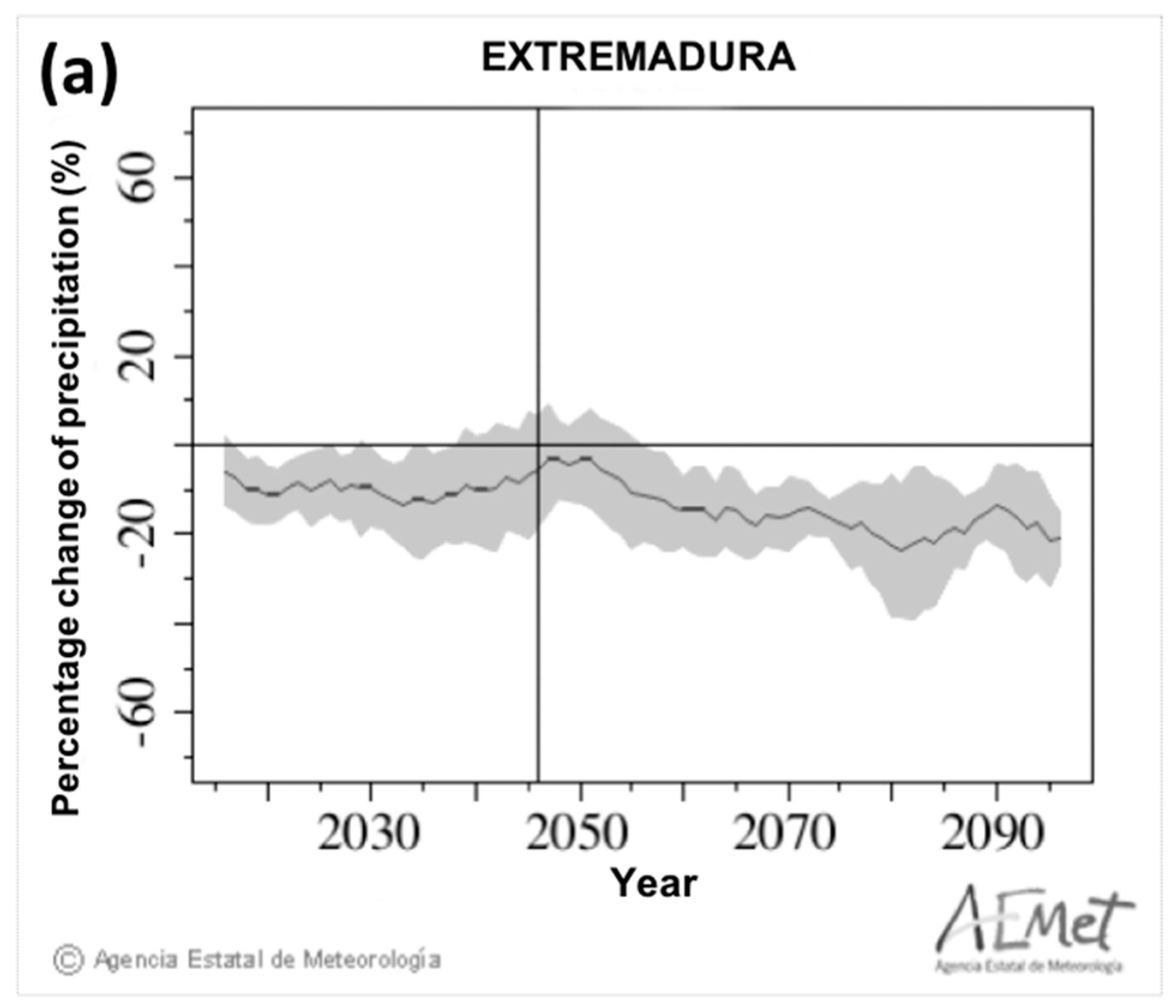
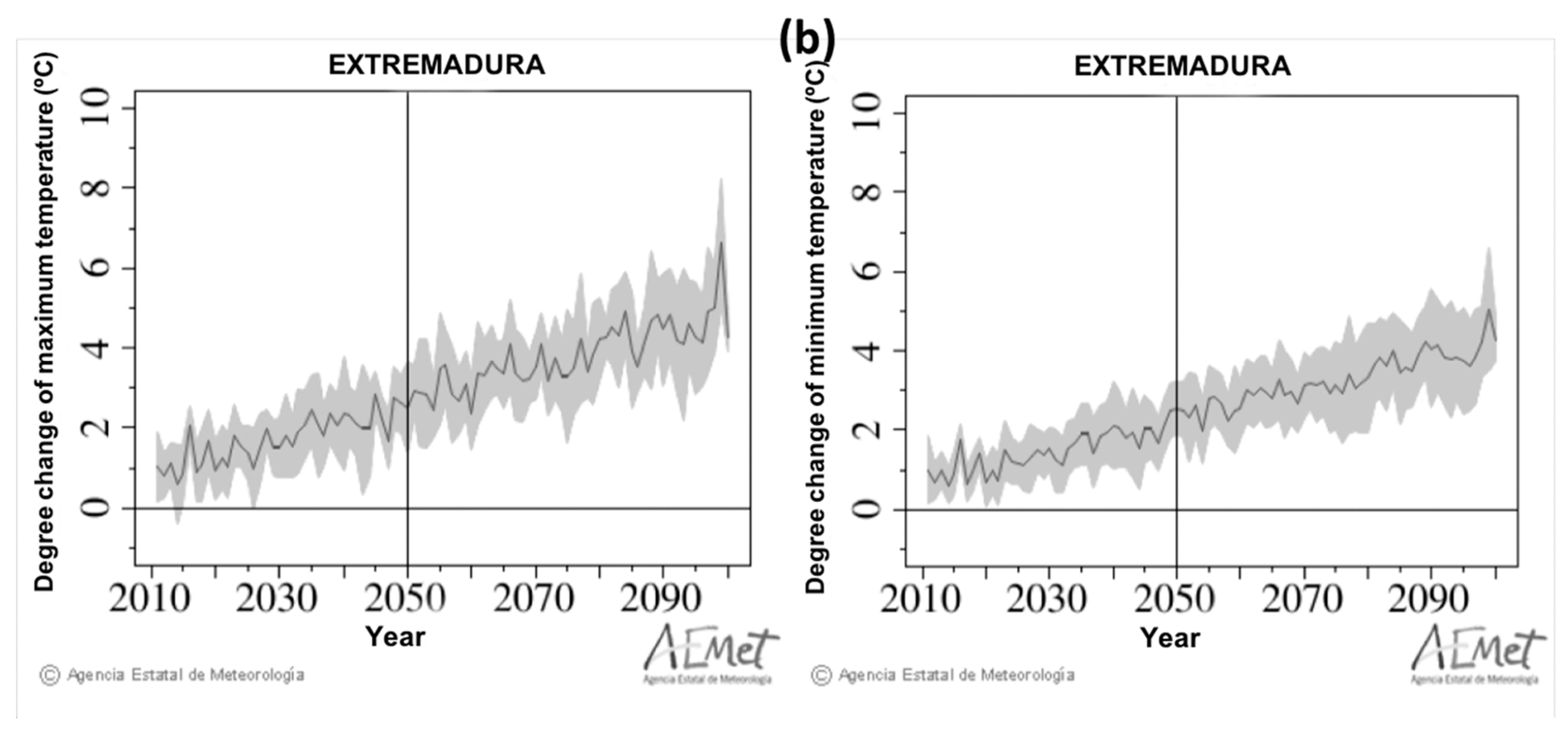

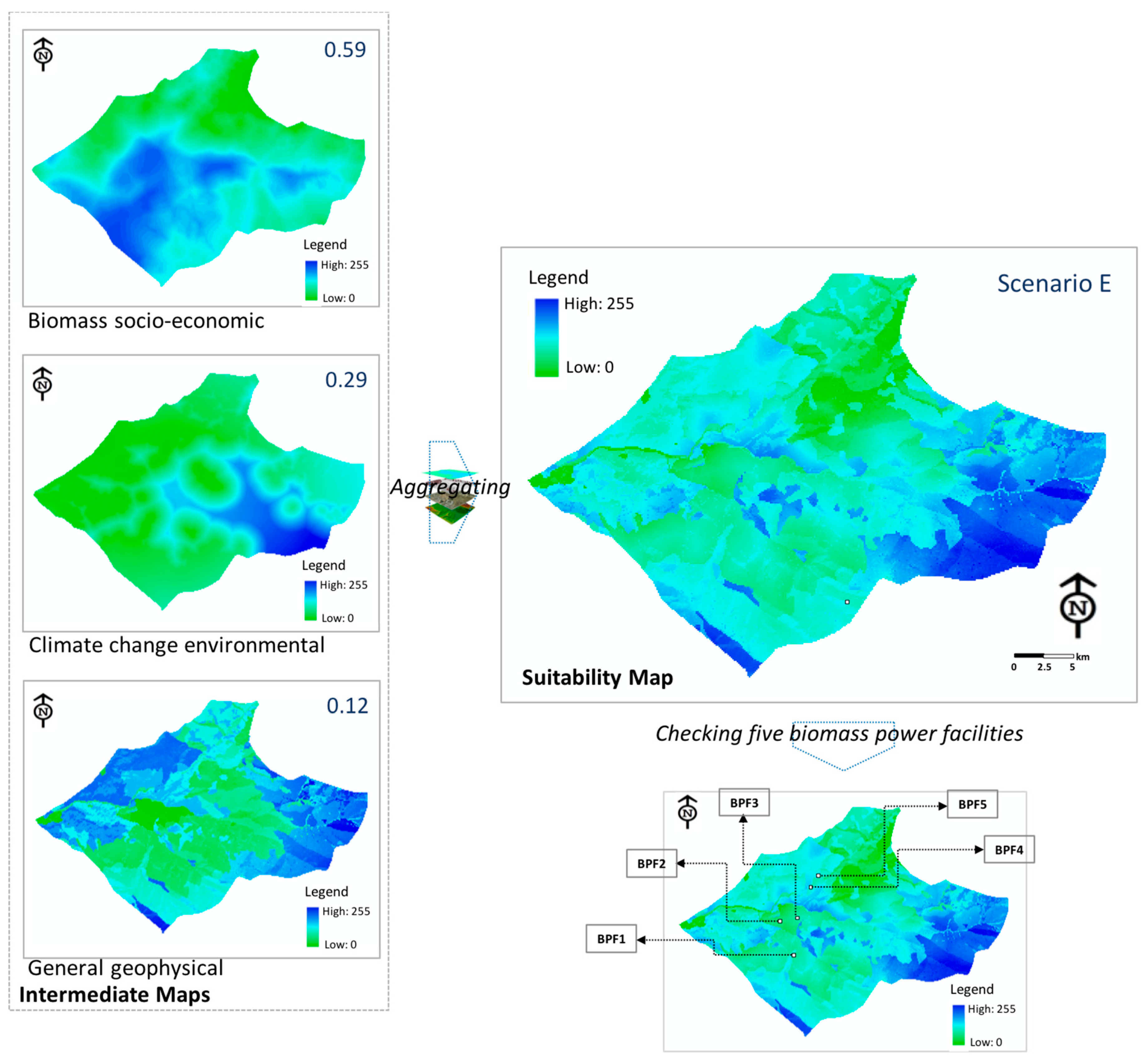
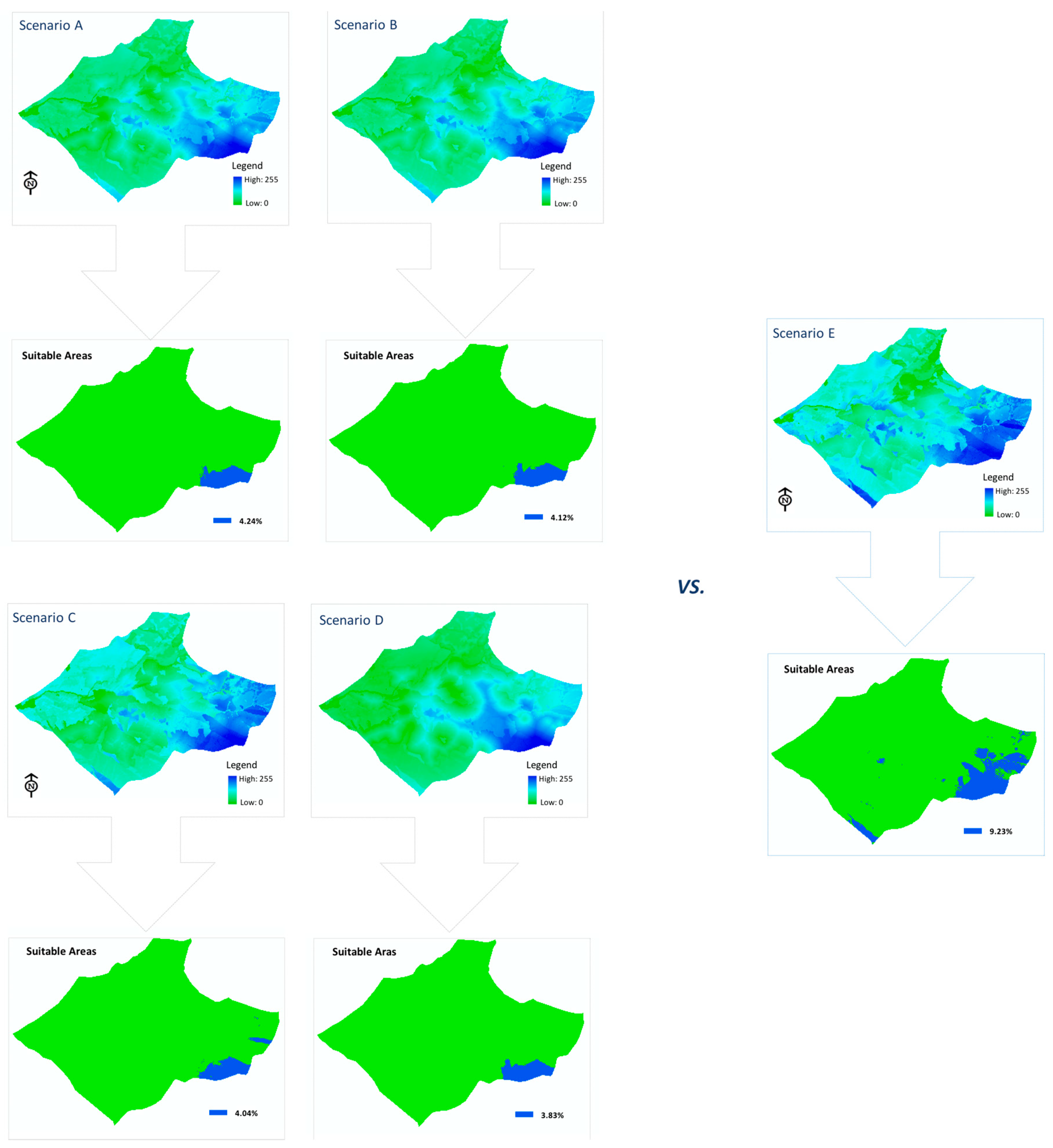
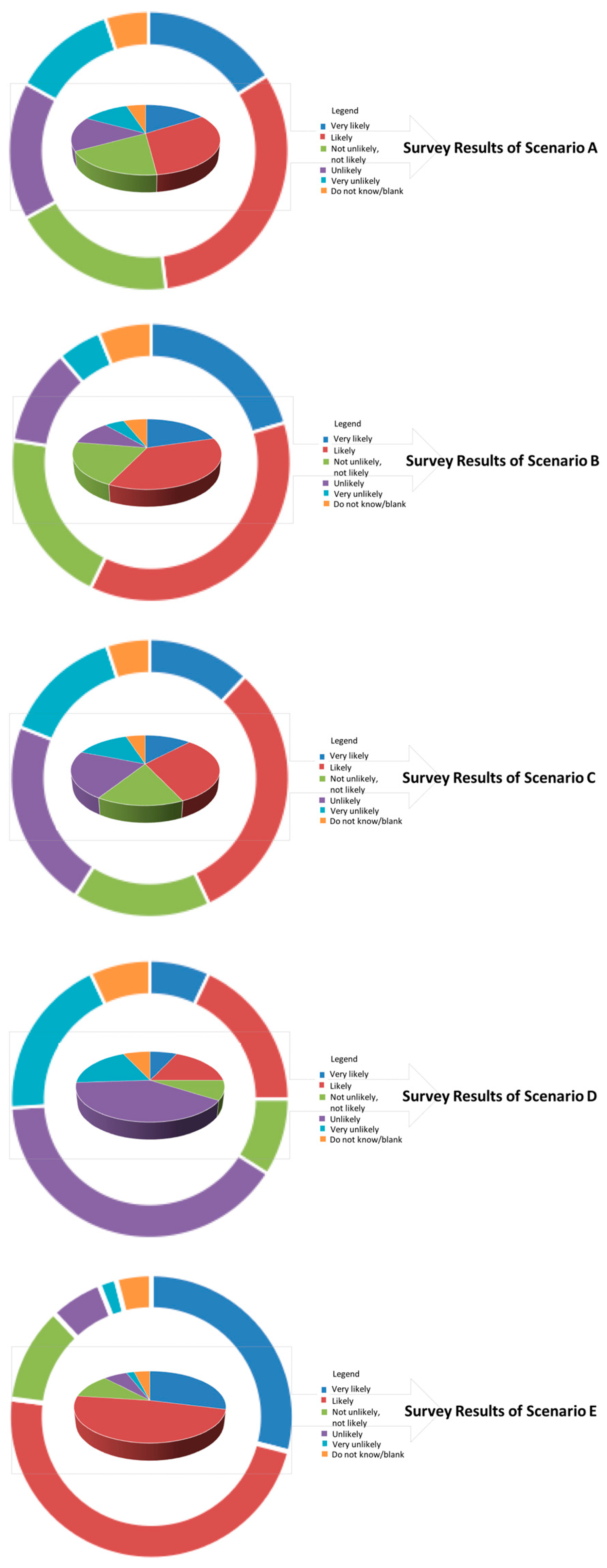
| Territorial Type (Area) | Surface (ha.) | Percentage (%) |
|---|---|---|
| Reservoir and urban | 66,646 | 1.60 |
| Agricultural | 938,368 | 22.54 |
| Peripheral agricultural | 326,792 | 7.84 |
| Forest | 2,831,651 | 68.02 |
| Criteria | Description | Acronym | |
|---|---|---|---|
| Biomass socio-economic | Potential demand | Areas identifying spatial coverage classification of energy utilization and demand, and spatial articulation of potential demand with the 0.26 criterion weight. | PD |
| Transport cost | Areas specifying spatial coverage classification of biomass assembly and distribution cost, and spatial articulation of transport cost with the 0.56 criterion weight. | TC | |
| Site access | Areas depicting spatial coverage classification of transport grids (highways, local roads, and railways) and spatial articulation of site access with the 0.05 criterion weight. | SA | |
| Economic area | Areas explaining spatial coverage classification of socio-economic activities and population density, and spatial articulation of economic area with the 0.13 criterion weight. | EA | |
| Climate change environmental | Temperature | Areas specifying spatial coverage classification of pleasantness and relating with average worth of annual temperature rises, and spatial articulation of temperature with the 0.28 criterion weight. | TE |
| Precipitation | Areas identifying spatial coverage classification of rough distribution of annual precipitation and involved with geomorphology impacts, and spatial articulation of precipitation with the 0.39 criterion weight. | PR | |
| Biodiversity | Areas describing spatial coverage classification of ecologically protected by the European commission for biodiversity and nature policy by NATURA 2000 and the regional law by LESOTEX, and spatial articulation of biodiversity with the 0.13 criterion weight. | BI | |
| Hydrology | Areas demonstrating spatial coverage classification of water bodies (springs and/or wells) and main and secondary streams of water surface followed by European Union (EU) water directive, and spatial articulation of hydrology with the 0.20 criterion weight. | HY | |
| General geophysical | Geology and soil | Areas relating to spatial coverage classification of earth modules assortment and spatial articulation of geology and soil with the 0.23 criterion weight. | GS |
| Orientation | Areas specifying spatial coverage classification of better phase for aesthetical intention and spatial articulation of orientation with the 0.20 criterion weight. | OR | |
| Vegetation cover | Areas describing spatial coverage classification protecting natural developments and spatial articulation of vegetation cover with the 0.39 criterion weight. | VC | |
| Visibility | Areas identifying spatial coverage classification of aesthetic fortification and appraisal, and spatial articulation of visibility with the 0.18 criterion weight. | VI | |
| More Important | Description | Less Important |
|---|---|---|
| 9 | More or less extreme importance or preference | 1/9 |
| 8 | More or less very to extremely strong importance or preference | 1/8 |
| 7 | More or less very strong importance or preference | 1/7 |
| 6 | More or less strong to very strong importance or preference | 1/6 |
| 5 | More or less strong importance or preference | 1/5 |
| 4 | More or less moderate to strong importance or preference | 1/4 |
| 3 | More or less moderate importance or preference | 1/3 |
| 2 | More or less equal to moderate importance or preference | 1/2 |
| 1 | Equal importance or preference | 1 |
| Intensity | Category | A (%) | B (%) | C (%) | D (%) | E (%) |
|---|---|---|---|---|---|---|
| 0 | Do not know | 5 | 6 | 5 | 7 | 4 |
| 1 | Very unlikely | 12 | 5 | 14 | 19 | 2 |
| 2 | Unlikely | 16 | 11 | 22 | 40 | 6 |
| 3 | Not unlikely or likely | 19 | 20 | 16 | 9 | 11 |
| 4 | Likely | 32 | 36 | 31 | 18 | 48 |
| 5 | Very likely | 16 | 20 | 12 | 7 | 29 |
| Overall (Point) | 3.09/5 | 3.31/5 | 2.90/5 | 2.33/5 | 3.84/5 | |
© 2018 by the author. Licensee MDPI, Basel, Switzerland. This article is an open access article distributed under the terms and conditions of the Creative Commons Attribution (CC BY) license (http://creativecommons.org/licenses/by/4.0/).
Share and Cite
Jeong, J.S. Biomass Feedstock and Climate Change in Agroforestry Systems: Participatory Location and Integration Scenario Analysis of Biomass Power Facilities. Energies 2018, 11, 1404. https://doi.org/10.3390/en11061404
Jeong JS. Biomass Feedstock and Climate Change in Agroforestry Systems: Participatory Location and Integration Scenario Analysis of Biomass Power Facilities. Energies. 2018; 11(6):1404. https://doi.org/10.3390/en11061404
Chicago/Turabian StyleJeong, Jin Su. 2018. "Biomass Feedstock and Climate Change in Agroforestry Systems: Participatory Location and Integration Scenario Analysis of Biomass Power Facilities" Energies 11, no. 6: 1404. https://doi.org/10.3390/en11061404





